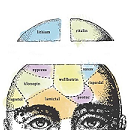“Service members suffering from PTSD often feel like they’re wearing a mask,” Samantha Allen writes in Invisible Wounds. Melissa Walker, an art therapist, asks them to make one. “The results are stirring. One mask, striped in red and black with hollow chrome-colored eyes, is wrapped in razor wire with a lock where its mouth should be.”
-
As one who has run various art programs for children, I agree it’s amazing how much one can learn about what’s going on inside another’s mind, based upon the art they create.
In one of my programs, I had a child who created something very dark and chaotic. It concerned me a little, so I spoke with his grandmother. She ended up showing me the drugs that child was on. I checked for drug interactions, and low and behold, the child was on a drug cocktail with major drug interaction warnings. It does strike me the doctors should be checking for these, not the artists, however.














